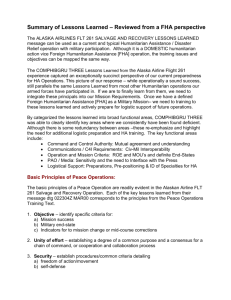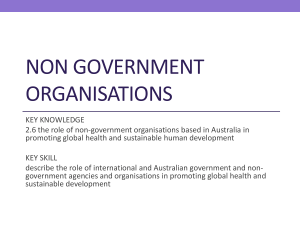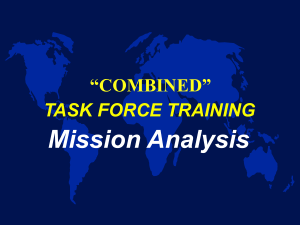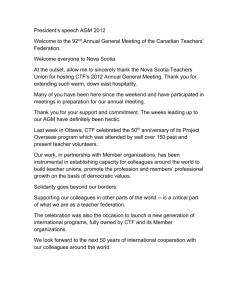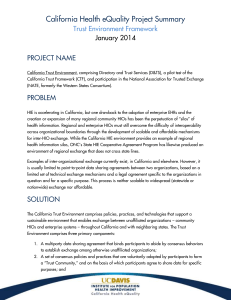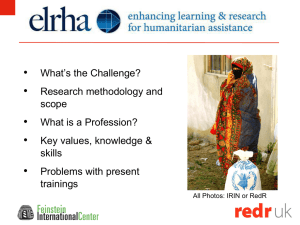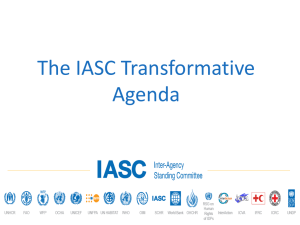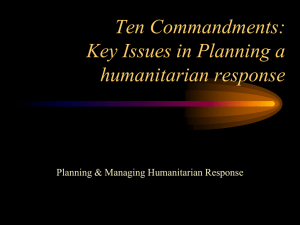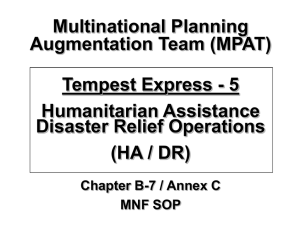Final HADR OVERVIEW
advertisement
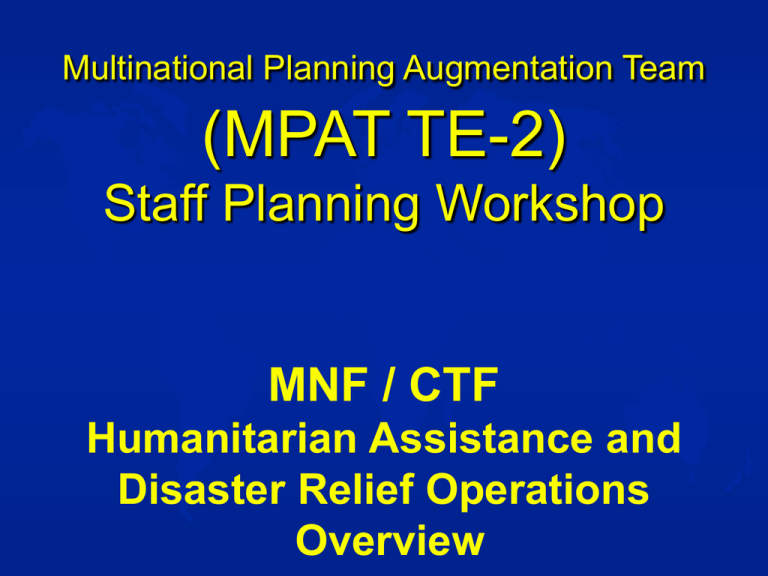
Multinational Planning Augmentation Team (MPAT TE-2) Staff Planning Workshop MNF / CTF Humanitarian Assistance and Disaster Relief Operations Overview Purpose Broad introduction of Civil Affairs Considerations in Humanitarian Assistance Operations I Terminology II The Players III US Organizations IV NGOs/IO V Transition to a Non Military Effort UN DOS/EMB VI VI COA Development OFDA/DART NGOs Military Perspectives on Multinational Operations “Allies are the most aggravating of people. They are so difficult to understand, so unreasonable; they approach quite straightforward problems from such extraordinary angles. Even when one agrees with them on common objectives their methods towards obtaining them are so queer, so very queer. They even introduce consideration of their own national politics and hangovers from their past history, none of which have the faintest bearing on the matter of immediate issue. Their most annoying characteristic, however, is that among all the arguing and haggling is the astonishing way they seem quite incapable of recognizing how sound, how wise, how experienced are our views; how fair, indeed how generous, how big hearted we are..” Field Marshall William Slim Humanitarian Assistance Operations Provide Comfort - Turkey/N. Iraq (HA) Sea Angel I & II - Bangladesh (HA) Fiery Vigil - Philippines (HA) Guantanamo/Panama-- Haitian Refugees (HA) Provide Hope - Former Soviet Union (HA) Provide Relief - Kenya/Somalia (HA) Restore Hope - Somalia (HA) Provide Promise - Former Yugoslavia (HA) Pacific Haven - Guam (HA) East Timor (PO / HA) Earthquake Relief - India (HA) TYPES OF HA OPERATIONS COMPLEXITY UN Unilateral TYPES OF OPERATIONS HA/DR RESPONDERS HOST-NATION GOVERNMENT UNITED NATIONS IO s INTERNATIONAL ORGs (INT’L RED CROSS) NGO’s/PVO’s Non-Governmental/ Private Volunteer Orgs MNF / CTF OFDA OFFICE OF FOREIGN DISASTER ASSISTANCE SUPPORT EMBASSIES Ambassadors/Chiefs of Mission Responsible for Overall Direction, Coordination, and Supervision of Supporting Government Activities in the Host Country Responsible for Successful Completion of the HA/DR and Safety of their Government’s Citizens For the US: State Department = Lead Federal Agency for HA Ambassadors/Chief of Missions The Ambassador Is Not in the Military Chain of Command but a US JTF/CTF Commander Will Fully Support the Ambassador’s Plans and Cooperate With Lead Federal Agency / DOS and Embassy Personnel, Without Compromising Mission Requirements Pg I-6 and II-3, JP 3-07.5 NGO / PVO RELATIONSHIP TO THE MNF / CTF “What’s the relationship between a justarrived military force and the NGOs and PVOs that might have been working in a crisis-torn area all along? What we have is a partnership. If you are successful, they are successful; and if they are successful, you are successful. We need each other.” GEN J. M. Shalikashvili, CJCS MNF / CTF COMMANDER Responsible for all phases of the military operation Provides short-term assistance Provides military assistance to Governmental and Non-governmental agencies Capacity Building Establishes Liaison teams Orchestrates the transition of responsibilities to other agencies Civil Military Operations Center (CMOC) Coordination Center – – – Humanitarian Operations Coordinating Center (HOCC) Humanitarian Assistance Coordinating Center (HACC) Civil Military Coordination Center (CMCC) Composite force, multinational Provides a centralized location for coordinating military support to non-military organizations InterAction CARE Doctors of the World Red Cross ICRC OFDA / DART NGOs & PVOs Intl Rescue Committee CMOC USG Agencies Save the Children UN Children’s Fund Country Team Dept of Peacekeeping Operations World Food Programme High Commissioner for Refugees Requests for Assistance Non-military organizations submit requests for Assistance (RFA) to CMOC CMOC validates requirements (w/ HN, UNOCHA, OFDA) CMOC forwards validated requirements to military commander for approval Approved RFAs tasked to units by CTF C3 CMOC provides venue to coordinate execution between military and nonmilitary organizations OPERATIONAL ENVIRONMENT UNCERTAIN PERMISSIVE MNF/ CTF HOSTILE OPERATIONAL ENVIRONMENT Permissive: Little or no threat to military forces. Normally associated with Humanitarian Assistance/Disaster Relief operation r Common purpose – Quantifiable problem – Clear objectives – Host Nation cooperation Uncertain: Host Nation government does have total and effective control over the territory and population in the Area of Operations Hostile: range from civil disorder or terrorist actions to full-scale combat – Multiple conflicting parties – Imminent danger to all parties – Relief effort may be manipulated by combatants for political gain – Potential for relief to be used by combatants TRANSITION PLANNING FUNCTIONS AND RESPONSIBILITIES TRANSITION CRITERIA FISCAL GUIDANCE TRANSITION PLAN TRANSITION AND / OR TERMINATION COA DEVELOPMENT STEPS--HA / DR 1. Coordinate with HA Partners (Host Nation, UN, IO, NGO/PVOs, Lead Government Agencies, etc.) 2. Determine threat / operational environment(s) 3. Analyze force capabilities 4. Array force capabilities (HA, security, medical, transportation, etc.) 5. Develop scheme of maneuver 6. Determine C2 means and maneuver control measures 7. Prepare COA statement and sketch 8. Prepare staff estimates HA / DR DISCUSSION ITEMS Symbology and maps- Depiction of non-military operations What is the role of traditional Intel in support of HA/DR The role of PSYOP and CA Operational Environment/Force Protection Lessons Learned (Cont’d) Each operation differs- No universal doctrine & SOPs Plan inclusively- include non-military players Know the HA partners and how they support the mission Understand the media: Objectives; scope of assistance; military endstate Don’t underestimate people’s coping skills
